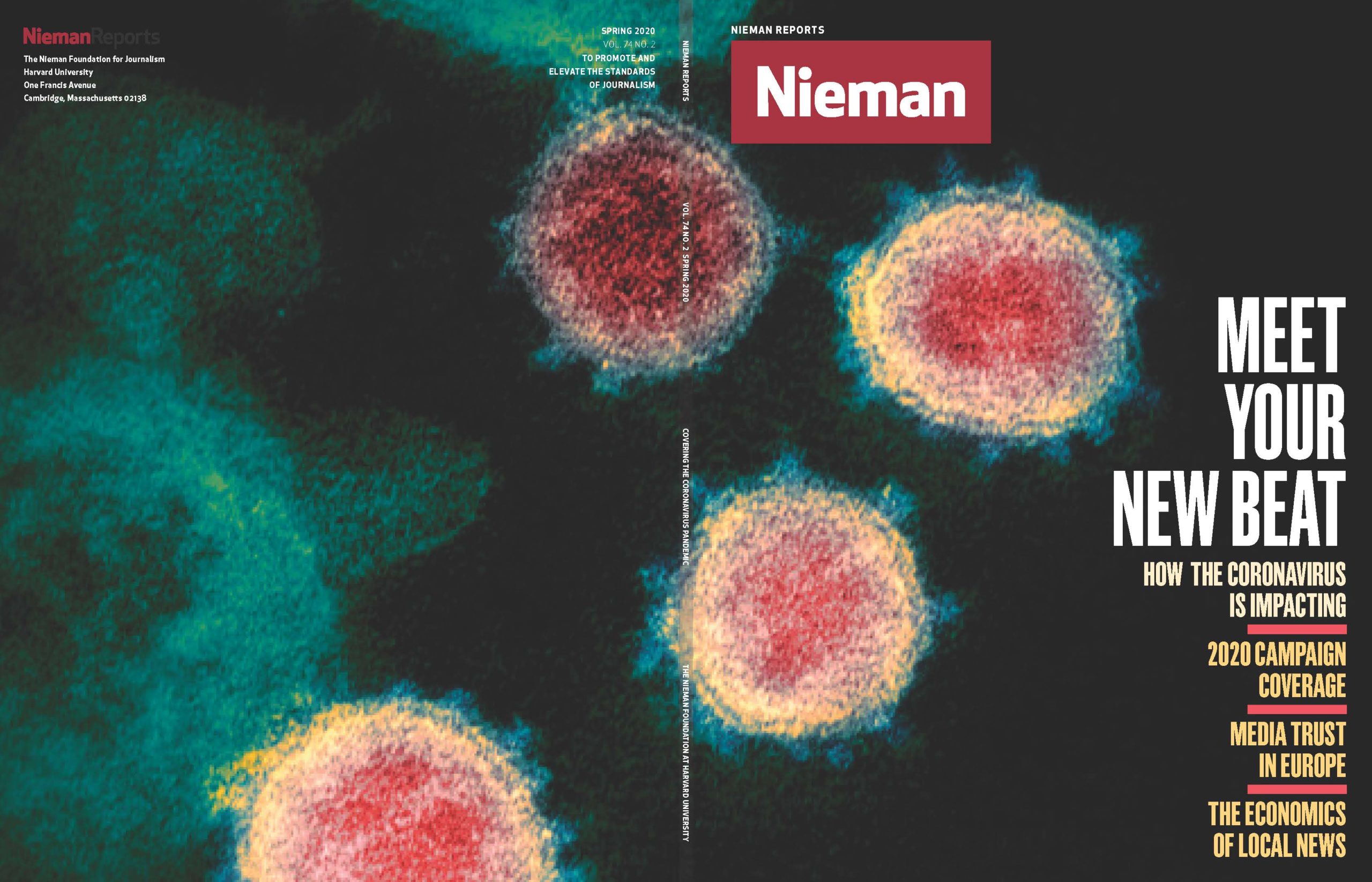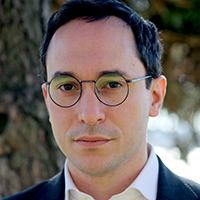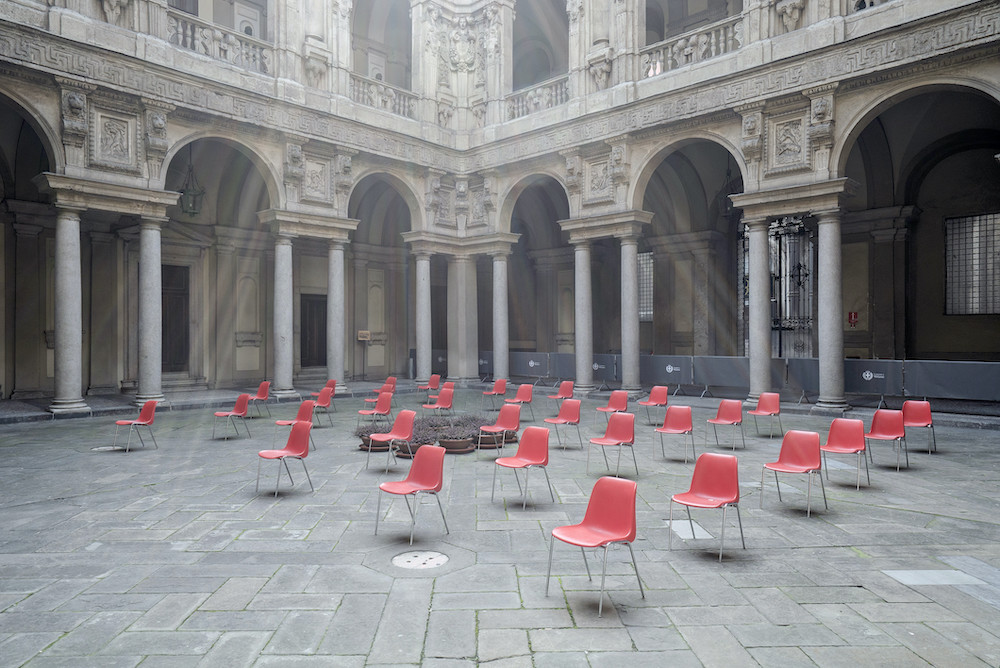
At Palazzo Marino in Milan, home to the city’s municipal headquarters, chairs are placed outdoors and at a safe distance before a meeting
Media are going through a similar process. What are the essential values for journalism in a moment when reliable information is decisive but the prospects for the already battered news industry look grim, if not apocalyptic?
Trust is most essential. Without it, even a stable media industry doesn’t matter because people won’t believe it.
Outbreaks and massive emergencies have always been hotbeds for disinformation. Chronicles from the plagues during the Middle Ages show that many of today’s basic dynamics surrounding misinformation were already in place. The notion of pestilentia manu facta, or man-made epidemic, was first introduced by the Roman author Seneca and played a significant role in the Black Death epidemic, in the mid-1300s, when many in Europe accused the Jews or foreigners of purposely spreading the disease.
Without trust, even a stable media industry doesn’t matter because people won’t believe it
Journalism should be an antidote to the misinformation pandemic. In a way, these extraordinary circumstances are a giant “trust test” for the media.
Are European media winning back — or increasing — the public’s confidence through coverage of the pandemic? With a few exceptions, not so much.
A recent global survey by Edelman on trust during Covid-19 shows that journalists are the least trusted source of information regarding the pandemic, even though a significant majority of the population worldwide gets its updates about the coronavirus through well-established national media. Data collected March 6-10 in Brazil, Canada, France, Germany, Italy, Japan, South Africa, South Korea, the U.K., and the U.S. show that scientists are the most trusted source regarding the novel coronavirus, at 83 percent. Only 43% consider the media trustworthy on Covid-19, making journalists less trusted than co-workers, NGO representatives, politicians, and “a person like yourself.”
Confidence in the media in the European Union has been declining over the past five years. A 2019 Ipsos survey shows that trust generally decreased across Europe, but the impact of the relative decline varies greatly from country to country. For instance, trust in newspapers and magazines in Germany decreased by 12% between 2014 and 2019, but 65% of Germans still trust newspapers. In Spain, 57% do not trust newspapers and magazines very much or at all, and distrust is even higher for online news platforms.
Overall, the survey conducted between January and February 2019, shows a stark division between highly-trusted media in countries like Germany and Sweden, and low-trust media in southern Europe, most notably in Spain.
Distrust in the media has dramatically increased in France, mostly because of the Yellow Vests protests coverage and the widespread perception of a growing divide between ordinary citizens and the Parisian élite. Italy stands in the middle of the trust curve, as half of the country generally trusts journalists, while the other half actively distrusts them. The resurgence of nationalism and the spread of authoritarian and illiberal tendencies in Eastern Europe sent the trust index plummeting there, especially in countries like Serbia and Hungary.
Trust won’t change the industry’s bottom line or fix dysfunctional business models. But it could be the cornerstone upon which to start to rebuild the commercial fundamentals of journalism after the pandemic is passed. Continental Europe was hit by the coronavirus outbreak before the United States, so an overview of how European media – in Italy, Spain, France, and Germany – have dealt with the emergency may suggest some preliminary considerations regarding the trust trajectory in journalism.
Italy
A study conducted by the Milan-based firm TradeLab in mid-March – when the country had already been in lockdown for a little over a week and the death toll had surpassed 2,500 – shows that confidence in media was low. Asked whether the health emergency was accurately represented by the media, 46% of respondents strongly disagreed; only 16% said the coverage was balanced and transparent. By comparison, 31% said the government and health officials were portraying the situation more accurately.
“Our research reflects people’s disappointment in national media coverage during the first weeks of the emergency,” says TradeLab co-founder Paolo Bertozzi, adding that local media are less trusted now than before the pandemic. Even though there’s an appetite for coverage of how the pandemic is affecting local communities, Bertozzi says, “our survey indicates the public is looking for highly-qualified voices capable of unpacking the complexity of the situation,” expertise not commonly available among financially strapped local Italian news outlets. “We interpreted these trends as a clear request for a more responsible approach by the media.”
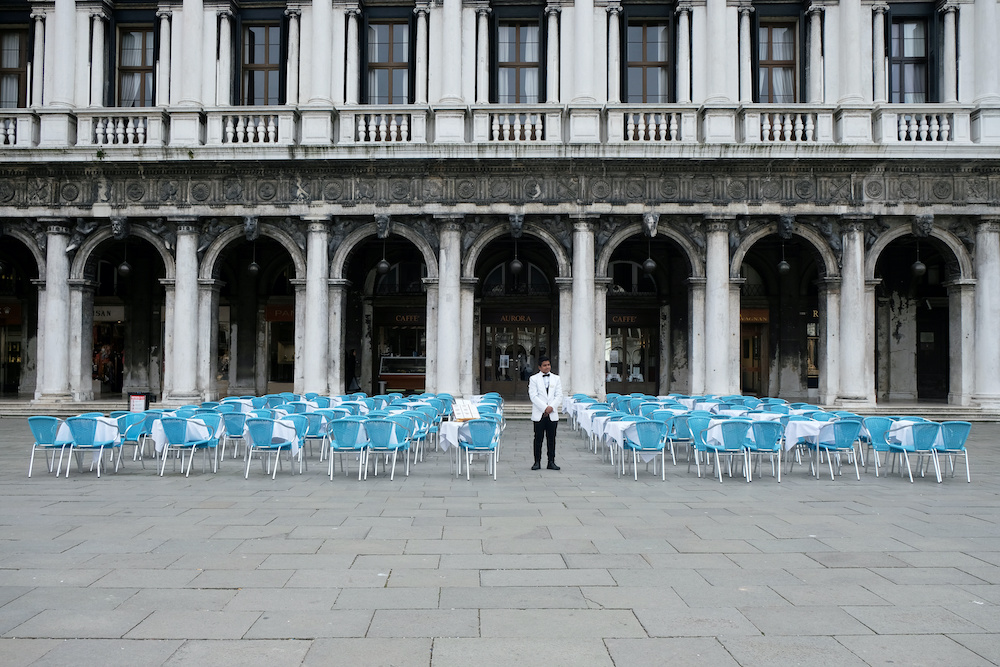
A waiter stands by empty tables outside a restaurant in Venice’s St. Mark’s Square, which is usually full of tourists, in March 2020
What went wrong? The intense politicization of media is one dimension. Especially in the early days of the outbreak, media coverage echoed the quarrelsome ecosystem of Italian politics. The result was a mix of alarmism and under-estimation, mostly reflecting politicians’ attitudes and agendas.
Italian newspapers and magazines are quite openly engaged in political debate, thanks also to the noticeable absence of firewalls between newsrooms and editorial pages. The old power structure was partially shaken when La Repubblica, one of the newspapers with the widest circulations and an openly left-leaning voice, was acquired by the Agnelli family’s Exor, which owns the Turin-based La Stampa and is the major stakeholder in The Economist Group. La Repubblica’s main competitor, the centrist Il Corriere della Sera, is part of the RCS group, which publishes, among others, the conservative-leaning daily El Mundo in Spain.
On February 27, a week after the first Covid-19 case was confirmed in Lombardy, a giant headline on La Repubblica’s front page blared “Let’s re-open Milan,” quoting the Democratic mayor of the city, Beppe Sala. At that point, schools in Milan had been closed for several days, but the mayor was pushing to go back to normal life, against the advice of Lombardy’s governor, Attilio Fontana, a member of the right-wing populist party The League. Most of the national media insisted on the back-to-normal narrative.
The same day, World Health Organization Director-General Tedros Adhanom Ghebreyesus warned that the epidemic in Italy and elsewhere “demonstrate[s] what this virus is capable of” and pushed even countries with no confirmed cases to move swiftly. The next day, no major newspaper in Italy mentioned WHO’s warnings on its front pages. “Faced with increasingly dramatic circumstances, Italian media weren’t able to get rid of their typical flaws,” says Luca Sofri, the editor of Il Post, an independent online outlet focused on explanatory journalism: “Fear and discord.”
Peddling alarms and sowing conflicts, he says, are the main criteria Italian media apply for selecting and presenting news in ordinary times. “But in extraordinary times like these, media should be more careful than usual, as our responsibilities dramatically increase. That just didn’t happen,” Sofri says.
Giuseppe De Bellis, editor-in-chief of the all-news channel SkyTG24, thinks that after a rocky start, Italian media are now generally reporting fairly on the crisis. “Most of the fake news circulating at the beginning of the outbreak has been debunked and marginalized,” says De Bellis. “An excessive rush to publish unverified scoops before the competitors is now giving way to a more responsible attitude by the media.”
Especially in the early days of the outbreak, media coverage echoed the quarrelsome ecosystem of Italian politics
Il Post emerged as a go-to source for clear and noise-free reports on the pandemic. A combination of Vox-style explainers unpacking basic scientific notions, carefully reported pieces on areas particularly hit by the pandemic, and well-sourced stories on its broader effects on society – for instance, the shortage of fresh food in grocery stores, as European agriculture heavily depends on immigrant workers – offered readers an alternative to the rushed and heavily politicized coverage of some legacy media. The timing was also relevant. Il Post launched a coronavirus-dedicated newsletter on February 24, four days after the first case was confirmed in Italy. La Repubblica started its themed newsletter on March 13.
Il Post traffic, Sofri says, almost tripled during the first weeks of the emergency, and the revenue from subscriptions significantly increased. Il Post is free, and it has an optional monthly plan that rewards subscribers with an ad-free experience. Despite the success of some independent media, early surveys on Covid-19 coverage suggest Italy is hardly experiencing a surge in media trust.
Spain
In Spain, where a lockdown has been in place since March 15, media initially focused on factual reporting and were generally supportive of government measures. “That attitude lasted maybe a week, then the traditional polarized instincts kicked in again,” says Hector Fouce, a media theorist at the Universidad Complutense in Madrid. He notes the “national emergency” narrative slowly gave way to more political coverage.
Sometimes factions try to rewrite history. Health authorities issued no public warning against the March 8 Women’s March, and conservative politicians in Madrid for instance not only didn’t call for the suspension of the march, but they actually joined the march. The closest thing to a warning was a general recommendation to all European countries from the ECDC (the European equivalent to the CDC) on March 2 to be careful with large gatherings, especially indoors. The fact that the march went ahead as planned is an issue that conservatives and (especially) the far-right are using, but there was no health warning at the time. That weekend there were still soccer games and a large gathering, indoors, of the far-right party Vox; unfortunately, few were aware of the danger.
In Spain, the three major newspapers are marked by their political orientations. El País, part of the media conglomerate PRISA – which also controls the largest private radio station, Cadena SER – is openly left-leaning and generally aligned with the socialist party PSOE, currently leading a fragile coalition government with the left-wing populist Podemos and some independentist parties. El Mundo’s center-right editorial line jibes with the agenda of the People’s Party, and in 2014 its editor-in-chief and co-founder, Pedro J. Ramírez, was fired after exposing an illegal financing scheme in the party led by then Prime Minister Mariano Rajoy. The daily ABC represents social conservatives and its views are inspired by the Catholic faith. Along with legacy media, a number of native digital outlets have been gaining traction, such as El Español, eldiario.es, El Confidencial, and público.es.
Since the beginning of the Covid-19 emergency, Spanish outlets have produced some remarkable journalism and aggressively reported on the government’s faults in dealing with the crisis. For instance, El País reported that the much-needed quick testing kits purchased by the government from a Chinese company were unreliable. The government bought 640,000 faulty kits and pre-ordered 5.5 million more.
The Socialist Prime Minister Pedro Sánchez has been criticized for declaring a state of emergency too late and underestimating the warnings coming from Italy. When the wave of infections hit, the Spanish health system was hardly prepared to handle it, and hospitals experienced a massive shortage of protective equipment. Health care workers unions are suing the authorities for not protecting their members, who got infected at rates higher than anywhere else in the world.
Sanchez’s popularity is plummeting. A survey by the Spanish firm GAD3 shows that government approval ratings dropped to 27.7%, from around 35% before the emergency, making the socialist leader the only head of government in Western Europe who’s losing support. By contrast, the same research, conducted near the end of March, suggests trust in media has been rising during the emergency: 54% of Spaniards said they have a good opinion of the media.
Another debate involving the role of journalists stemmed from El Mundo’s controversial decision to publish on its front page a picture with dozens of coffins lined up in a popular Madrid ice rink that was turned into a morgue. For the first time during the coronavirus crisis, the Spanish people were confronted with images that visually depicted the scope of the tragedy. El Mundo defended its choice to use a photo that “challenges the government and the Spanish civil conscience in a drastic and unavoidable way,” and other media have complained about the strict limitations put on photojournalists covering the harshest dimensions of the crisis. The digital newspaper El Independiente called it a “censored tragedy.”
María Ramírez, director of strategy at eldiario.es, says much of the public criticism among Spaniards seems to be focused on the government response rather than on the media. “Trust is also measured in terms of subscribers,” Ramírez says, noting that since the beginning of the emergency eldiario.es moved from 36,000 members to about 50,000. The digital newspaper, founded in 2012 and owned by its journalists, doesn’t have a paywall but asks its readers to pay a recurring fee to support its mission. Roughly one-third of its revenue comes from their community members, known as socios.
Many established outlets in Europe gained new subscribers during the crisis, but most of them offer discounted subscriptions. eldiario.es instead increased its annual fee from €60 to €80 as part of an emergency plan to compensate for the loss of ad revenue, which also included self-imposed salary cuts in the newsroom.
As in other countries, the emergency is drawing people mostly to legacy media, but some data journalism outlets like Datadista are gaining traction for their engaging, user-friendly presentation of stats on the pandemic. Datadista is doing granular analysis of the main figures provided by the health authorities on confirmed cases, people who recovered, number of victims, and hospital capacity. But it’s also providing simple explanatory videos on government subsidies for commercial activities and the self-employed, maps of gas stations still operating, and heavily researched analysis on unemployment and the economic impact of the Covid-19 crisis.
Founded in 2016 by investigative reporters Antonio Delgado and Ana Tudela, Datadista specializes in data analysis and visualization and was behind several in-depth investigative works, such as Playa Burbuja, a two-year-long project that unveiled a vast network of corruption in the real estate market on the Spanish Mediterranean coast.
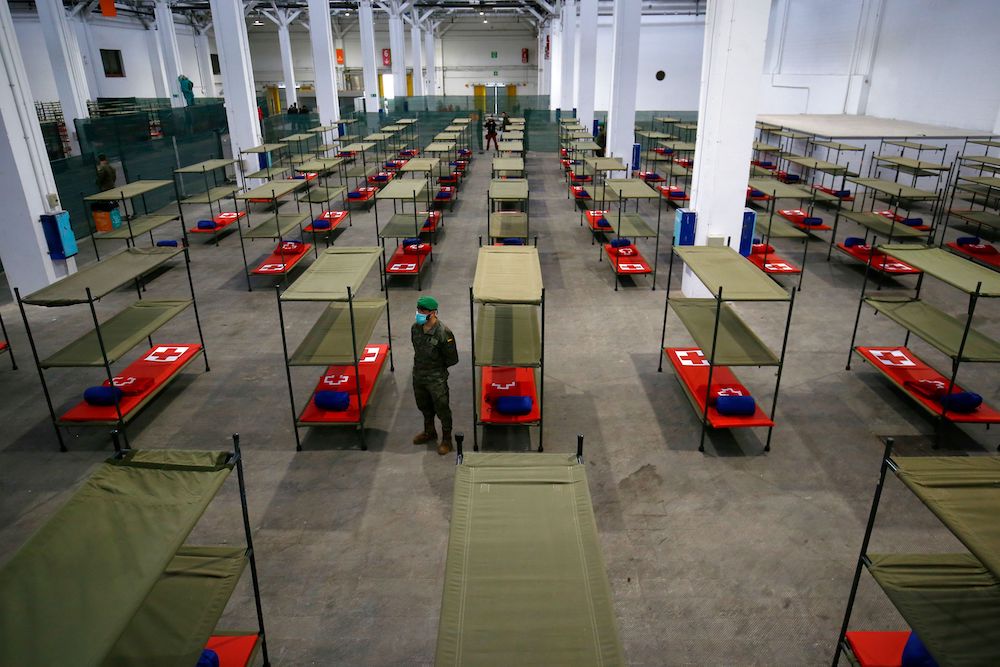
A Spanish soldier stands next to beds set up at a temporary hospital for vulnerable people at the Fira Barcelona Montjuic, a convention center, in Barcelona on March 25, 2020
France
A single story on the epidemic in France sums up all the tensions that have been ravaging the national conversation in the past few years, including the elements that contributed to a remarkable erosion in media trust: the debate around Didier Raoult, the iconoclastic microbiologist who’s suggesting treating Covid-19 patients with a therapy based on hydroxychloroquine, an anti-malaria drug. Raoult’s hypothesis, which has been tested so far only on a small sample of patients, was enthusiastically endorsed by Donald Trump and touted on Fox News, but was met with skepticism by many scientists. French media are aggressively covering a dispute whose nature is not purely scientific but has deep cultural and political implications.
Raoult is from Marseille, in the south of France, and frames his understanding of the present as a struggle between the French people and the Parisian élite. The 68-year-old director of the Méditerranée Infection Institute enjoys a cult-like following on social media, and his theories have been warmly endorsed by anyone wanting to strike a blow against officially validated experts. Emmanuel Macron’s decision to pay a surprise visit to the doctor in Marseille suggests the story, in France, goes beyond its clinical dimension. Journalists too have been entangled in this cultural clash.
The 2019 Digital News Report by the Reuters Institute ranked France last among European countries in terms of public confidence in the media. The Yellow Vests protests – started in the fall of 2018 as a protest against rising taxes on gas, then morphed into an anti-establishment movement advocating for economic justice – only exacerbated mistrust in reporters. Journalists struggled to cover in a balanced way an elusive, grassroots movement that sparked violent clashes around the country and became a vehicle for the frustrations of both the far-right and the far-left. Protesters were successful in portraying mainstream media as government-friendly entities, encouraging their sympathizers to look for alternative sources of information on social media and elsewhere.
During the protests, the all-news channel BFM TV, known for its sensationalist and inflammatory reporting, became one of the most popular and yet most criticized broadcasters in the country. Outlets like RT France, the French version of the Russian television channel RT, and the Kremlin-controlled agency Sputnik gained traction among online news brands. The decision of President Macron to treat them as “propaganda organs” indirectly contributed to their popularity among Yellow Vests supporters.
Le Monde, Le Figaro, and Libération are the three main legacy newspapers, characterized by different political inclinations. Le Figaro is the voice of conservatives, while Libération, co-founded by Jean-Paul Sartre on the heels of the 1968 movement, progressively moved from the Marxist left to more mainstream progressive ideas. While formally not affiliated with any political stance, Le Monde is broadly associated with center-left values.
The Covid-19 emergency provides an opportunity to rebuild trust
France has also a strong tradition of regional newspapers, like the widely-circulated Ouest-France, in the Western region of the country, or La Voix du Nord, based in the northern city of Lille. Among digital native outlets, the investigative website Mediapart, founded in 2008, is a staple in French political journalism. Last year, the subscription-based outlet reached 170,000 members and switched to a nonprofit structure to secure its editorial independence.
The Covid-19 emergency provides an opportunity to rebuild trust. In the past few weeks, several legacy media websites and broadcasters broke their previous audience records, and in March the heavily criticized BFM TV had its best month in history, showing again the ambivalent relationship between trustworthiness and popularity. “What is relevant is that digital subscriptions to local press are also doing well,” says Alice Antehaume, executive director of Sciences Po Journalism School, pointing to a trend not seen elsewhere in Europe. “We could imagine that when confined in a specific town, people want to know more about the number of cases in the area they are concerned about.”
Unlike Spain and Italy, France may be seeing a more effective suspension of the political engagement that traditionally characterizes national media. Arnaud Mercier, a communication science professor at the Université Paris 2, sees a significant change in attitude by the media since the emergency started. (France has been in lockdown since March 17.) “Media have tried from the early stage to provide useful and clear information to the public, sticking to the facts and giving voice to experts, while relying less on opinion and editorials,” says Mercer. “The public is generally not very fond of journalists, but I think the dramatic circumstances are temporarily bridging this divide.”
Le Monde has put in place tools to engage its audience in a more personal way. “When people really care about what’s happening, they tend to go to legacy media to get reliable information and authoritative, fact-based analysis,” says Cécile Prieur, Le Monde’s deputy editor. “That’s why we are stressing the importance of strengthening the relationship with our community.”
For its Covid-19 coverage, Le Monde introduced “Live,” a continuous stream of updates on the pandemic driven by a dedicated team, operating every day from 5 a.m. to midnight. On “Live” – a tool that has been used for several years for breaking news and big, developing stories – readers can interact with questions and comments, and reporters strive to provide timely and clear answers. This service, which is not paywalled – Le Monde has a freemium model – gathers around 1 million visits per day, getting on average 4,000 to 5,000 questions from users. A slower “Live” section dedicated to life in lockdown is also active on the website on a daily basis, where readers can share their experiences and reflections.
At the end of March, Le Monde launched an explanatory WhatsApp thread providing a selection of verified news and practical information to navigate the daily routine of the pandemic. Subscribers to this free feature can also flag suspicious messages and unverified information on what has probably been the platform most hit by misinformation. The legacy daily produces also the podcast “Pandémie,” which has been consistently near the top of the most downloaded in the country.
Germany
Covid-19 has hit Germany somewhat later, compared to Italy, Spain, and France, and so far the country has been able to contain the number of victims, thanks to its massive ability to test and to its robust health care system. The German media landscape is also solid and generally trusted. The major daily newspapers are defined both by their regional areas and by political orientation. The Süddeutsche Zeitung, headquartered in Munich, has a center-left outlook; the Frankfurter Allgemeine Zeitung is generally associated with a center-right position, and Die Welt is a conservative outlet. The left-leaning Der Spiegel is the most widely circulated weekly magazine in the country, while Die Zeit is a liberal newspaper.
Despite being generally trusted, in recent years German media have gone through a series of challenges. In 2015, the refugee crisis coverage pushed public trust in journalism to its lowest point, and far-right parties like Alternative Für Deutschland waged a vocal campaign to discredit what it called the government-serving “lying press” and question public financing for federal broadcasters. The relative decrease in trust was also fueled by the case of a prize-winning journalist, Claas Relotius, who was discovered to have falsified facts for his stories in Der Spiegel.
Media observatories in Germany are currently studying the impact of the coronavirus coverage on media trust, but preliminary observations suggest Germans are generally satisfied with reporting that is mostly data-oriented and led by legacy media. “My sense is that people are flocking around established sources of news,” says Carsten Reinemann, a communications professor at the Ludwig-Maximilians University in Munich. “That does not mean there isn’t fake news, conspiracy theories and bad, sensationalistic reporting out there. But my feeling is that this crisis might strengthen the image of and trust in quality journalism, and public service broadcasting in particular.”
“This is obviously a crucial time for explanatory data journalism,” says Uli Köppen, head of data journalism at the German public broadcaster Bayerischer Rundfunk (BR). She co-leads an investigative data team and has built a newly created AI team at the Munich-based network, but the Covid-19 emergency turned their focus to what she calls “bread-and-butter data journalism.”
“We’re really focused on processing and explaining the numbers in a way that is understandable for the public, without being too fancy about visualization,” Köppen says, starting with an automated map that monitors confirmed cases and drew significant traffic. “Users need to understand what’s happening, and we have to carefully explain what the numbers are saying and what they are not saying.” Her data team is doing also some investigative work on the spread of the Coronavirus in Germany.
For instance, BR analyzed the Instagram accounts of thousands of people who between the end of February and early March visited the popular ski town of Ischgl, in Austria, one of the hotspots of the contagion in Europe. Tourists moved then as far as Turkey, Portugal, and Iceland, but the vast majority returned to Germany, where they contributed to spreading the virus before any social distancing measures were in place.
The urgency of the coronavirus threat is also strengthening the demand for reliable information, providing a chance for media to correct its own flaws
“We are working a lot to make our users understand that the numbers are not the truth, but approximate estimates of what’s happening,” says Vanessa Wormer, an investigative reporter who leads a data team at the Süddeutsche Zeitung and was part of the Panama Papers global team. “There’s also a lot we don’t know. Some of them are confused by the fact that also experts disagree, and one thing we’ve been focusing on is explaining the different sets of assumptions upon which different scientific hypotheses are based.”
For instance, her team created a “corona simulation” exploring different scenarios of the outbreak, explaining why some scientists suggest the curve should be stopped, not just flattened. The paywalled story brought many new subscribers to the daily. “I can’t think of any other time in data journalism when visualization was so important,” says Wormer.
The effort to carefully present audiences with data-based, expert-driven reporting on the pandemic comes with some questions over the role of journalists. “While media in Germany are generally providing a good service to the public in need of information, I am concerned we are missing a debate about the role of journalism,” says Mario Haim, a professor of data journalism at the University of Leipzig. “There’s a lot of very useful data visualization on numbers of infected and victims in different countries, presented in a way that reminds me of the Olympics medal table. But the reporting mostly echoes the words of political leaders and experts are sometimes given the stage without the mediation of journalists.”
The pandemic poses an existential threat to the media industry at a global level. But the urgency of the threat is also strengthening the demand for reliable information, providing a chance for media to correct its own flaws. It could be a space for self-criticism and reorientation toward practices and standards that will, in time, rebuild trust.

